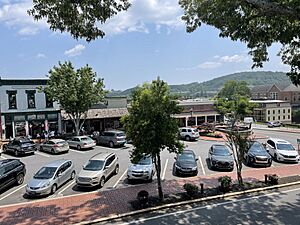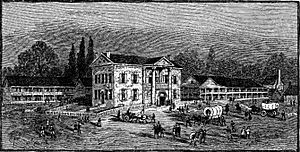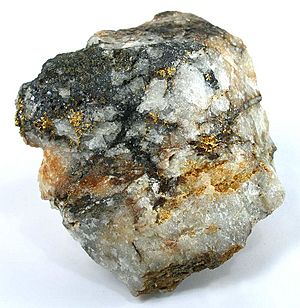Dahlonega, Georgia facts for kids
Quick facts for kids
City of Dahlonega
|
|||||
|---|---|---|---|---|---|
|
City
|
|||||

Historic Lumpkin County Courthouse, which now houses the Dahlonega Gold Museum Historic Site
|
|||||
|
|||||
| Nickname(s):
Gold City
|
|||||

Location in Lumpkin County and the state of Georgia
|
|||||
| Country | United States | ||||
| State | Georgia | ||||
| County | Lumpkin | ||||
| Government | |||||
| • Type | Council–manager | ||||
| • Body | City Council | ||||
| Area | |||||
| • Total | 8.87 sq mi (22.97 km2) | ||||
| • Land | 8.82 sq mi (22.84 km2) | ||||
| • Water | 0.05 sq mi (0.14 km2) | ||||
| Elevation | 1,450 ft (442 m) | ||||
| Population
(2020)
|
|||||
| • Total | 7,537 | ||||
| • Density | 854.83/sq mi (330.06/km2) | ||||
| Time zone | UTC-5 (EST) | ||||
| • Summer (DST) | UTC-4 (EDT) | ||||
| ZIP codes |
30533, 30597
|
||||
| Area code(s) | 706 | ||||
| FIPS code | 13-21240 | ||||
| GNIS feature ID | 0355420 | ||||
Dahlonega (/dəˈlɒnɪɡə/ DƏ-lon-IG-ə) is the county seat of Lumpkin County, Georgia, United States. As of the 2010 census, the city had a population of 5,242, and in 2018 the population was estimated to be 6,884.
Dahlonega is located at the north end of Georgia highway 400, a freeway which connects Dahlonega to Atlanta. Dahlonega was named as one of the best places to retire by the publication Real Estate Scorecard.
Dahlonega was the site of the first major Gold Rush in the United States beginning in 1829. The Dahlonega Gold Museum Historic Site which is located in the middle of the public square, was originally built in 1836 as the Lumpkin County Courthouse. In 1849, when local gold miners were considering heading west to join the California Gold Rush, Dr. Matthew Fleming Stephenson, the assayer at the Dahlonega Branch Mint, tried to persuade miners to stay in Dahlonega. Standing on the courthouse balcony and pointing at the distant Findley Ridge, Dr. Stephenson was recalled in his speech as saying: "Why go to California? In yonder hill lies more riches than anyone ever dreamed of. There's millions in it," This phrase was repeated by those miners who did make the journey to California and was shared in the mining camps of the west. Years later, the young Samuel Clemens, better known as the author Mark Twain, also heard of Stephenson's phrase. Twain was so enthralled by the phrase "There's Millions In It," that he used it frequently in his book The Gilded Age. Over time, the phrase has been misquoted to the better-known "Thar's gold in them thar hills."
Contents
The Georgia Gold Rush
In 1829, the first documented discovery of gold was made in Georgia. As news of the discovery spread, thousands of would be get rich quick men flooded into the mountains looking for the yellow metal in the creeks and rivers. At that time in history, the frontier of Georgia bordered the Cherokee Nation. During the winter of 1829–1830, white gold prospectors began illegally crossing the Chestatee River into the Cherokee Nation in search of gold. After objections were made to the Federal Indian Agent in the territory, United States troops were sent in to forcibly remove the gold miners from the nation.
By 1831, Governor Gilmer (and later Wilson Lumpkin) of Georgia realized that it was impossible to remove the thousands of miners who had intruded into the Cherokee Nation. Gilmer saw an opportunity to claim the remaining Cherokee lands as part of Georgia. In 1832, the Georgia legislature voted to create ten new counties out of the former Cherokee Nation without regard to their sovereignty. Lumpkin County named after Governor Wilson Lumpkin, was created in December 1832. A year later the town of Taloneka or Talonega was named as the new county seat on December 21, 1833. The spelling was later changed to Dahlonega, derived from the Cherokee word meaning "yellow."
The spelling of the Cherokee word Da-lo-ni-ge-i was disputed by early correspondents; Featherstonhough, for example, wrote it as "Tahlonekay". The proper pronunciation of Dahlonega is (Dah-loe-nee-gee or Dah-lone-gay) in the Western Dialect of the Cherokee language. Da-lo-ni-ge'i does not mean gold but it simply means, Yellow.
Naming the city
The city was named "Talonega" by the Georgia General Assembly on December 21, 1833. The name was changed from Talonega by the Georgia General Assembly on December 25, 1837, to "Dahlonega", from the Cherokee-language word Dalonige, meaning "yellow" or "gold".
The Dahlonega Branch Mint
Due to the abundance of gold which was discovered in North Georgia, the United States Treasury Department decided to build a branch mint in Dahlonega. This allowed local miners a place to bring their gold deposits in exchange for hard currency. The Dahlonega branch mint was built in 1838 and operated from 1838 to 1861. The Dahlonega Mint, like the one also established in 1838 in Charlotte, North Carolina, minted only gold coins, in denominations of $1.00, $2.50 (quarter eagle), $3.00 (1854 only) and $5.00 (half eagle). It was cost-effective in consideration of the economics, time, and risk of shipping gold to the main mint in Philadelphia, Pennsylvania. The Dahlonega Mint was a small operation, usually accounting for only a small fraction of the gold coinage minted annually in the US.
In 1861, when the Civil War began, the mint closed due to lack of materials and manpower. After the war the U.S. government decided against re-opening the facility. By then, the U.S. government had established a mint in San Francisco. Given the large amount of gold discovered in California from the late 1840s on, the San Francisco and Philadelphia mints handled the national needs of coin minting. As a result, surviving Dahlonega coinage is today highly prized in American numismatics.
The University of North Georgia
After the end of the Civil War in 1865, the Dahlonega Branch mint remained closed. The building served as a barracks for US troops garrisoned here, and as a school for freed black students. In 1871, Hon. William P. Price, who had been elected to Congress from Dahlonega, petitioned the government to re-purpose the vacant mint building into a college. In 1873, the newly founded North Georgia Agricultural College, opened its doors from the ashes of the original Dahlonega Branch Mint. Over the years as the college grew, the names have changed from the original North Georgia Agricultural College, North Georgia College, North Georgia College and State University and the current designation as the University of North Georgia.
Wine and tourism

In recent years, Dahlonega and Lumpkin County have been recognized as "the heart of the North Georgia Wine Country". The county features multiple vineyards and five licensed wineries that attract many tourists.
The historic Dahlonega Square is a popular destination, with gift shops, restaurants, art galleries and studios, and wine-tasting rooms. In 2015, Senator Steve Gooch introduced Georgia Senate Resolution 125 officially recognizing Lumpkin County as the Wine Tasting Room Capital of Georgia.
The city's local festivals draw many visitors. "Bear on the Square", an annual three-day festival held the third weekend in April, marks the day that a black bear wandered onto the square. It features bluegrass and old-time music. "Gold Rush Days", an annual two-day event the third weekend in October, attracts over 200,000 people.
Dahlonega is home to the Holly Theatre.
Dockery Lake Recreation Area is located 12 miles North of Dahlonega, a US Forest Service campground on a man-made lake stocked with trout.
Historical marker
Located at 384 Mountain Drive, WPA Historical Marker 19 B-7 explains:
This court house, built in 1836, replaced the small structure used since the establishment of Lumpkin County in 1832. The town was named Dahlonega in October, 1833, for the Cherokee word Talonega meaning "golden."
From its steps in 1849, Dr. M.F. Stephenson, assayer at the Mint, attempted to dissuade Georgia miners from leaving to join the California Gold Rush. His oration gave rise to the sayings: "There's millions in it," and "Thar's gold in them thar hills."
Geography
Dahlonega is located in central Lumpkin County at 34°31′57″N 83°59′06″W / 34.53250°N 83.98500°W (34.5325, −83.9850). U.S. Route 19 passes through the east side of the city, leading north 34 mi (55 km) to Blairsville and south 65 mi (105 km) to Atlanta. Georgia State Route 400, a freeway which runs concurrently with US-19 to Atlanta, has its northern terminus 5 mi (8 km) south of the center of Dahlonega. State Routes 9 and 52 run concurrently around the south side of Dahlonega, joining US 19 on the southeast side. State Route 9 leads southwest 14 mi (23 km) to Dawsonville, while State Route 52 leads west 18 mi (29 km) to Amicalola Falls State Park. To the east State Route 52 leads 16 mi (26 km) to Clermont.
According to the United States Census Bureau, the city has a total area of 22.9 km2 (8.8 sq mi), of which 0.14 km2 (0.05 sq mi), or 0.60%, are water. The city is centered on a low ridge, with the west side draining to Cane Creek and the east side to Yahoola Creek. Both creeks flow south to the Chestatee River, part of the Chattahoochee River watershed. 1,720 ft (520 m) Crown Mountain is in the southern part of the city.
Demographics
| Historical population | |||
|---|---|---|---|
| Census | Pop. | %± | |
| 1840 | 671 | — | |
| 1850 | 735 | 9.5% | |
| 1870 | 471 | — | |
| 1880 | 602 | 27.8% | |
| 1890 | 896 | 48.8% | |
| 1900 | 1,255 | 40.1% | |
| 1910 | 829 | −33.9% | |
| 1920 | 690 | −16.8% | |
| 1930 | 905 | 31.2% | |
| 1940 | 1,294 | 43.0% | |
| 1950 | 2,152 | 66.3% | |
| 1960 | 2,604 | 21.0% | |
| 1970 | 2,658 | 2.1% | |
| 1980 | 2,844 | 7.0% | |
| 1990 | 3,086 | 8.5% | |
| 2000 | 3,638 | 17.9% | |
| 2010 | 5,242 | 44.1% | |
| 2020 | 7,537 | 43.8% | |
| U.S. Decennial Census | |||
| Race | Num. | Perc. |
|---|---|---|
| White (non-Hispanic) | 6,227 | 82.62% |
| Black or African American (non-Hispanic) | 245 | 3.25% |
| Native American | 19 | 0.25% |
| Asian | 133 | 1.76% |
| Pacific Islander | 10 | 0.13% |
| Other/mixed | 320 | 4.25% |
| Hispanic or Latino | 583 | 7.74% |
As of the 2020 United States census, there were 7,537 people, 1,873 households, and 1,086 families residing in the city.
Education
Lumpkin County School District
The Lumpkin County School District holds pre-school to grade twelve, and consists of three elementary schools, a middle school, and a high school. The district has 215 full-time teachers and over 3,511 students.
- Cottrell Elementary School
- Long Branch Elementary School
- Blackburn Elementary School
- Lumpkin County Middle School
- Lumpkin County High School
Higher education
Dahlonega is home to University of North Georgia (formerly named North Georgia College and State University), North Georgia College and North Georgia Agricultural College, the Senior Military College of Georgia and the second oldest public university in the State of Georgia. The University of North Georgia is one of six senior military colleges (along with the Public Campuses of Texas A&M University, the Citadel, the Virginia Military Institute and Virginia Tech, and the Private Campus of Norwich University). The campus' administration building, Price Memorial Hall, is topped with a spire covered with gold leaf from the town. The rotunda dome of the Georgia State Capitol in Atlanta is also covered with Dahlonega gold.
Other educational facilities
- Wahsega 4-H Center, an environmental education center and summer camp owned by the University of Georgia and administered through the UGA Cooperative Extension Service Georgia 4-H program
- Camp Glisson, a year-round retreat camp owned by the North Georgia Conference of the United Methodist Church
Notable people
- Cleo S. Cason, military librarian at Redstone Arsenal
- Sara Christian, NASCAR's first female driver
- Steve Gooch, Georgia state senator and majority whip
- Dallas Kinney, Pulitzer Prize-winning photographer
- Guy A. J. LaBoa, lieutenant general in the United States Army who commanded the 4th Infantry Division and First United States Army
- 6 Dogs, Rapper popular in the underground "Cloud Rap" movement
International relations
Twin towns – sister cities
Dahlonega is twinned with:
See also
 In Spanish: Dahlonega (Georgia) para niños
In Spanish: Dahlonega (Georgia) para niños







